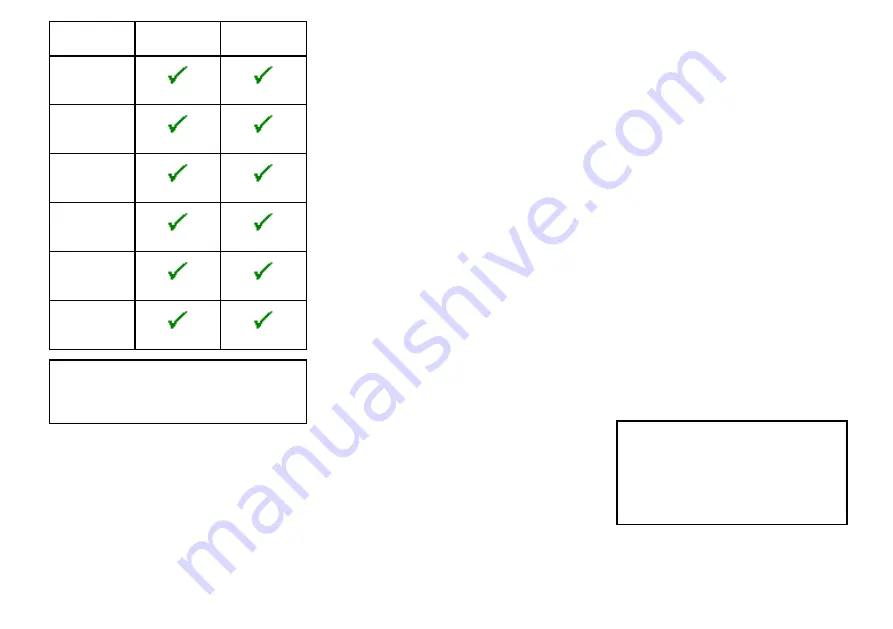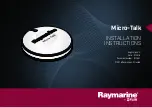
Data
Micro-Talk to
SeaTalkng®
SeaTalkng® to
Micro-Talk
Speed
(1)
or
(2)
Temperature
(1)
or
(2)
Heading
(1)
or
(2)
GPS
(2)
Time & Date
(2)
Navigation data
(2)
Note:
•
(1)
Requires T121 Wireless hull transmitter.
•
(2)
Requires T122 NMEA 0183 wireless interface.
Multiple data sources (MDS)
The Micro-Talk gateway is MDS compliant. If a data
type is available on the Micronet network then the
gateway will be selectable as a data source, for that
data type, from SeaTalkng® displays.
In installations where multiple sources of the same
data type exist on the Micronet network, the data
source that is used by the gateway and transmitted on
to SeaTalkng® will be the same data source that is
displayed on Micronet displays.
In installations where the same data types exist on both
networks then the MDS selected data source will be
shown on displays on both networks.
If MDS is set to
Auto
then the gateway will be the
preferred data source.
SeaTalkng®
SeaTalkng® (Next Generation) is an enhanced protocol
for connection of compatible marine instruments and
equipment. It replaces the older SeaTalk and SeaTalk2
protocols.
SeaTalkng® utilizes a single backbone to which
compatible equipment connect using a spur. Data and
power are carried within the backbone. Devices that
have a low draw can be powered from the network,
although high current equipment will need to have a
separate power connection.
SeaTalkng® is a proprietary extension to NMEA 2000
and the proven CAN bus technology. Compatible
NMEA 2000 and SeaTalk and SeaTalk2 devices can
also be connected using the appropriate interfaces or
adaptor cables as required.
Micronet
Micronet is a proprietary wireless Radio Frequency (RF)
network protocol compatible with Raymarine’s wireless
range of instrument displays and transducers.
Micronet can be used to connect up to 32 compatible
devices together to create a wireless marine electronics
network. Micronet products can operate on 1 of 2
frequencies depending on geographic location:
• 869.8 MHz for products operating in the UK, Europe
or Africa
• 915.9 MHz for products operating in the USA,
Canada, South America and Australia
Micronet products comply with the relevant ISM
regulations and are exempt from licensing in each of
these territories.
2.3 Networking restrictions
To ensure reliable system operation, certain restrictions
must be adhered to when using the Micro-Talk gateway.
•
Wireless interface (NMEA 0183)
When the
Micro-Talk gateway is used in a Micronet network that
has a Wireless interface (T122) present, to prevent
data looping, you must ensure that the Wireless
interface’s NMEA 0183 input/output connections are
NOT connected to an MFD or an NMEA 0183 to
SeaTalkng® converter that is connected to the same
network as the gateway.
•
Multiple Micro-Talk gateways
It is recommended
that only 1 Micro-Talk gateway is used per
SeaTalkng® network. After powering up if a gateway
detects another gateway it will shut itself down. It is
recommended that only 1 Micro-Talk gateway is used
per Micronet network. Bridging multiple SeaTalkng®
networks using Micronet is NOT recommended.
•
Data damping
The Micronet protocol applies
damping to data at source so that the data transmitted
on the network is more stable/consistent. On
SeaTalkng® networks the data is damped by the
displays. There is therefor a risk that data can be
double damped, once at source on Micronet and
then again by the SeaTalkng® display. To minimize
the effect of double damping, when the gateway is
powered up it will automatically send a message to all
Micronet displays and set their damping to the lowest
level. This may result in Micronet displays showing
rapidly changing data.
Note:
There may be small differences in
the data shown on Micronet displays to that
shown on SeaTalkng® displays due to the
effects of damping. You can manually alter the
damping settings on your displays to provide
a more stable/consistent reading. Damping
settings on Micronet displays are reset when
the system is power cycled.
Document and product information
11












































